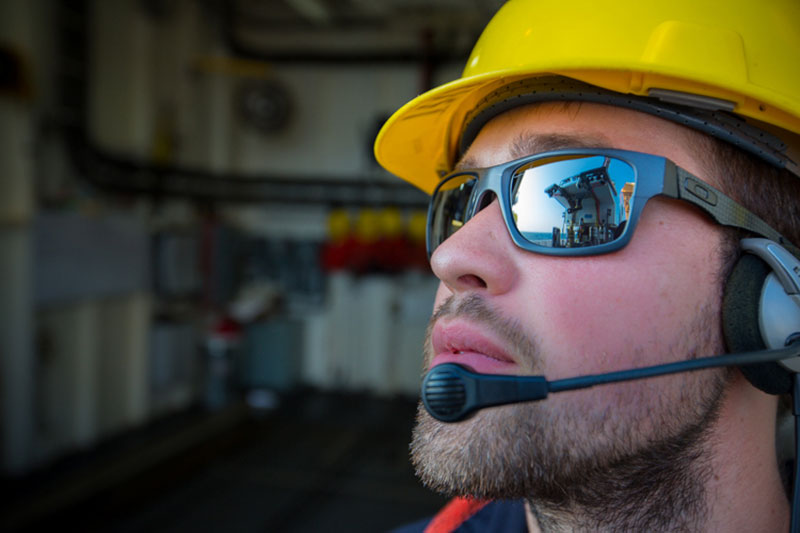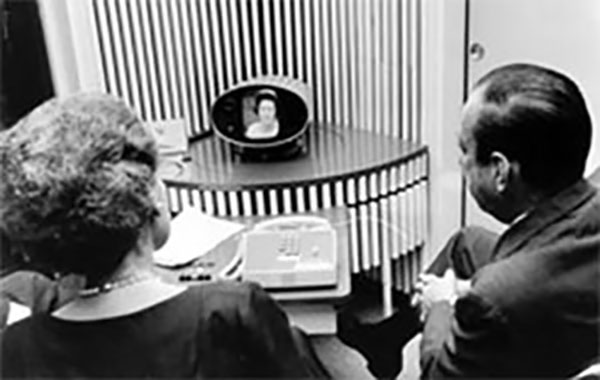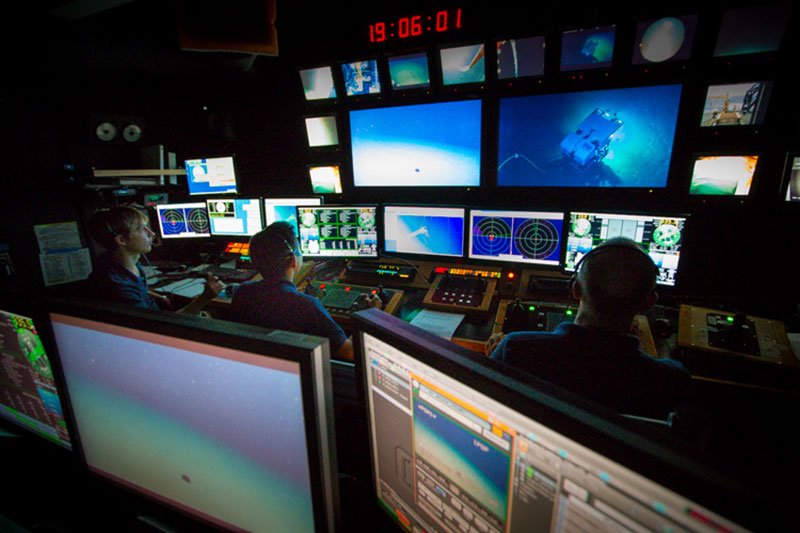
by Jared Drewniak, NOAA Office of Ocean Exploration and Research
August 9, 2013

It takes a diverse team with many kinds of skills to image the deepest regions of the ocean. Image courtesy of the NOAA Office of Ocean Exploration and Research, Northeast U.S. Canyons Expedition 2013. Download larger version (jpg, 261 KB).
The idea of telepresence is certainly not a new one. It’s an almost inevitable conclusion of our inborn desire to explore, our skill at crafting tools, and our relatively fragile physical nature. The desire to explore, to traverse distance and time, is a human drive trumped only by our basic survival needs. And even then there are many who would (and still do) risk life and limb to see what’s beyond the hill, above the sky, and below the sea.
If you want to get technical (and boy, do we love to get technical) early telescopes dating back to the 1600s could be considered telepresence technology.

The technical components of telepresence are older than you might think: Here, Mrs. Lyndon B. Johnson in Washington, DC, uses the Bell Labs PicturePhone to call Dr. Elizabeth Wood and then-Major Robert F. Wagner in New York City, in 1964. Download image (jpg, 36.5 KB).
Okay, well maybe that’s more technical-ity than technic-al. What about the first time images and audio were transmitted together? Electro-mechanical TVs date back to the 1920s. Need immediate two-way communication? The Bell Labs “Picturephone” dates back to 1964. We had “Face-Time” when TV stations were still broadcasting black and white! Even then, the modern videoconference unit as we know it didn’t become a mainstay of academic institutions and business until late 90s. And in the early 2000s, it entered the home via high-speed Internet and webcams.
But that’s ages in terms of technology. I mean, have you seen a cell phone from 2002? It had a screen like a calculator and apps that included talk, text, and (eventually) paperweight/doorstop.
So why, if we’ve had these tools, in one way or another, for so long does it seem that only recently the field of telepresence has gained such inertia?
Telepresence is more than cameras, computers, networks, and wires. It is a systematic approach to sharing data and experiences in near-real time. The gadgets are important but without method, expertise, and organization, they simply aren’t useful. It’s the difference between a toy and a tool.

The control room of the Okeanos is as well coordinated as any live television studio. Image courtesy of the NOAA Office of Ocean Exploration and Research, Northeast U.S. Canyons Expedition 2013. Download larger version (jpg, 414 KB).
Consider this:
A violin left in a room by itself will not make music. It requires the talent of a player. Even if you were in possession of the world’s finest Stradivarius, without a musician it would simply collect dust. And if you want to hear a symphony? You’ll need all the requisite instruments, players, a conductor, a good music hall, and maybe binoculars if you get stuck in the mezzanine...
And yet as a concert goer, these aren’t things you’d spend a lot of time thinking about. You get your tickets, throw on a nice suit jacket (or sweet denim jacket if you scored Van Halen tickets…), and just go to enjoy the experience. It’s transparent. That’s kind of the whole point. You’re there to get lost in the experience.
Good telepresence systems do the same thing. No matter how complex it actually is, to the user it should seem relatively simple. You aren’t thinking about data archival, signal paths, and how many channels of media richness you’re currently engaged in. You’re focused on the subject media and interactions stemming from it.
But we’ve had a long time to play with the system of music. And even today, we still play with the form and push the boundaries of musical performance. Telepresence is still incredibly nascent by comparison. There’s no “Telepresence University.” There simply isn’t the wealth of knowledge and experience to draw from that so many other technical pursuits benefit from.
My background is in broadcast television and distance education. And before that? I studied interpersonal communications and mass media. My colleagues come from data management, electrical engineering, computer science, satellite communications, mechanical engineering, and a vast bevy of ocean sciences and maritime professions. Each one is a “Jill/Jack Of All Trades” and usually a master of a few as well.
And therein lies the excitement. We get to make the road. We get to try new things. We get to experiment, and tinker, and refine. And we get to do all of that in the interests of science and exploration. I can’t think of a better use of the skilled minds and talented hands I get to work with aboard the Okeanos Explorer.
As the technological capabilities increase, so does the requisite variety. Meaning the more specialized and granular the technology becomes, the more kinds of talent we’ll need and the more we’ll be able to do with it. We’ll need experts in tested fields like storytelling/filmmaking and new ones like instructional design and big data.
So, what it telepresence? I’m my opinion, it’s a bunch of really smart people working hard to make it look easy.